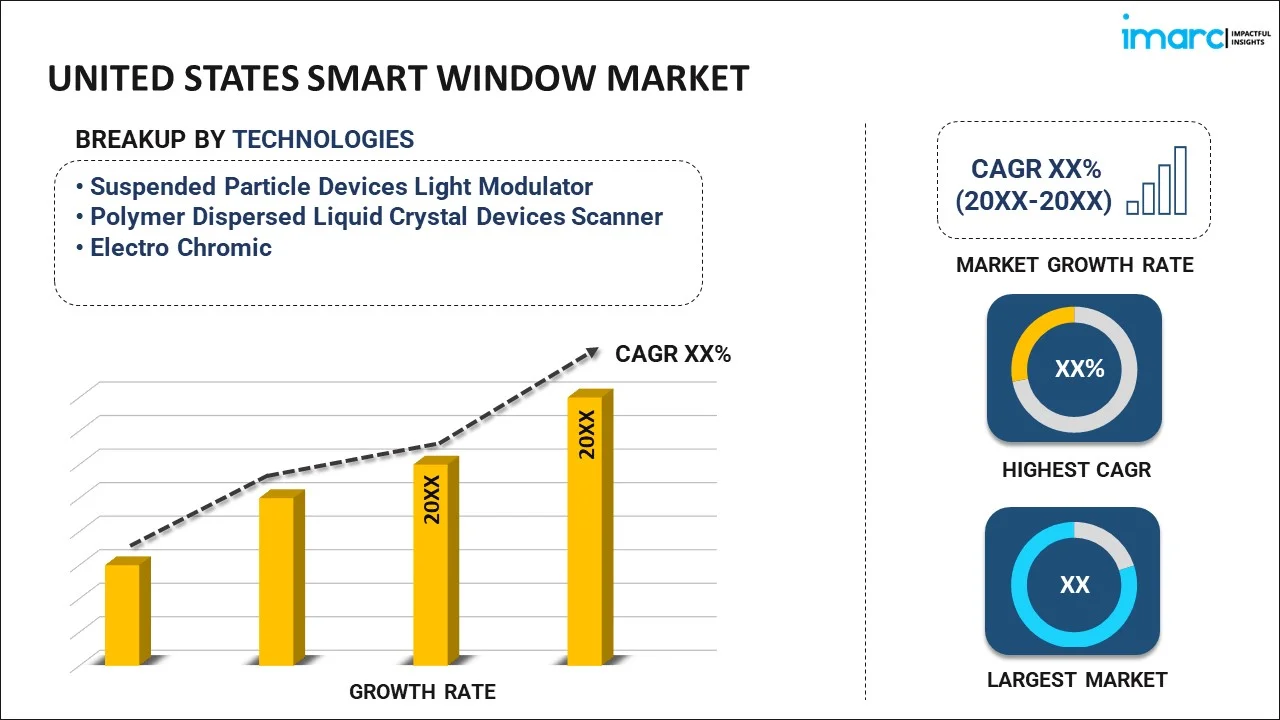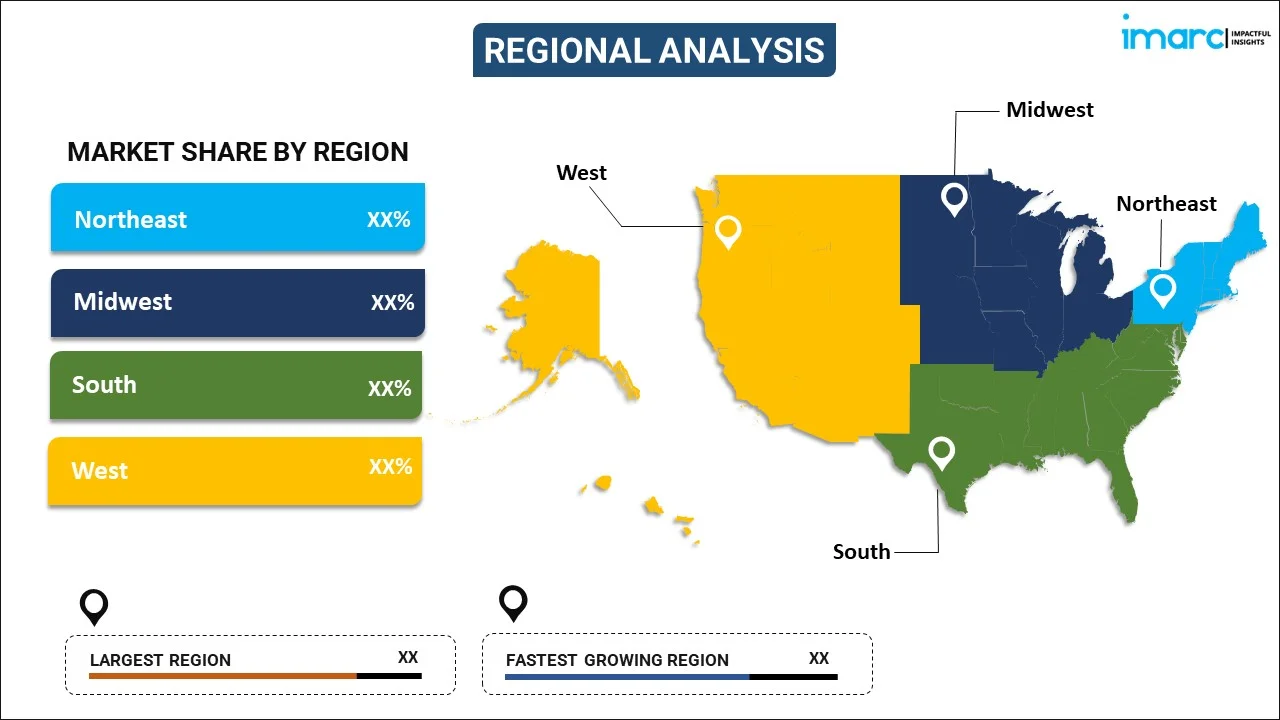
United States Smart Window Market Report by Technology (Suspended Particle Devices Light Modulator, Polymer Dispersed Liquid Crystal Devices Scanner, Electro Chromic), Type (OLED Glass, Self-Dimming Window, Self-Repairing), Application (Residential, Commercial, Industrial, Transport), and Region 2025-2033
Market Overview:
The United States smart window market size reached USD 2.1 Billion in 2024. Looking forward, IMARC Group expects the market to reach USD 5.1 Billion by 2033, exhibiting a growth rate (CAGR) of 9.70% during 2025-2033.
|
Report Attribute
|
Key Statistics
|
|---|---|
|
Base Year
|
2024 |
|
Forecast Years
|
2025-2033
|
|
Historical Years
|
2019-2024
|
| Market Size in 2024 | USD 2.1 Billion |
| Market Forecast in 2033 | USD 5.1 Billion |
| Market Growth Rate (2025-2033) | 9.70% |
Smart windows, or switchable windows, refer to the electronically powered windows that change color with variations in the voltage. They can change from transparent to opaque, which aids in regulating the amount of light entering a room. Some of the common materials used in these windows include electrochromic, liquid crystal and suspended particle glass. Smart windows can be controlled through a smartphone, switch or remote. They are usually installed to conserve energy by controlling the heat and light entering the room. As a result, these windows are extensively used in commercial and residential complexes and automobiles.
Significant growth in the construction industry, along with the increasing environmental consciousness among the masses, is one of the key factors creating a positive outlook for the market in the United States. Moreover, smart windows are increasingly being used in commercial and residential complexes to process solar power while minimizing solar gain in summers and maximizing it in winters. Additionally, the extensive utilization of smart windows in the automotive sector is acting as another major growth-inducing factor. These windows are used for reducing eye strain caused by glares, regulating heat in the vehicles and minimizing the exposure to ultraviolet (UV) rays. Other factors, including the implementation of favorable government regulations encouraging the use of energy-efficient products, are anticipated to drive the market further across the country.
Key Market Segmentation:
IMARC Group provides an analysis of the key trends in each sub-segment of the United States smart window market report, along with forecasts at the country and regional level from 2025-2033. Our report has categorized the market based on technology, type and application.
Breakup by Technology:

- Suspended Particle Devices Light Modulator
- Polymer Dispersed Liquid Crystal Devices Scanner
- Electro Chromic
Breakup by Type:
- OLED Glass
- Self-Dimming Window
- Self-Repairing
Breakup by Application:
- Residential
- Commercial
- Industrial
- Transport
Breakup by Region:

- Northeast
- Midwest
- South
- West
Competitive Landscape:
The competitive landscape of the industry has also been examined along with the profiles of the key players.
Report Coverage:
| Report Features | Details |
|---|---|
| Base Year of the Analysis | 2024 |
| Historical Period | 2019-2024 |
| Forecast Period | 2025-2033 |
| Units | Billion USD |
| Technologies Covered | Suspended Particle Devices Light Modulator, Polymer Dispersed Liquid Crystal Devices Scanner, Electro Chromic |
| Types Covered | OLED Glass, Self-Dimming Window, Self-Repairing |
| Applications Covered | Residential, Commercial, Industrial, Transport |
| Regions Covered | Northeast, Midwest, South, West |
| Customization Scope | 10% Free Customization |
| Post-Sale Analyst Support | 10-12 Weeks |
| Delivery Format | PDF and Excel through Email (We can also provide the editable version of the report in PPT/Word format on special request) |
Key Questions Answered in This Report:
- How has the United States smart window market performed so far and how will it perform in the coming years?
- What has been the impact of COVID-19 on the United States smart window market?
- What are the key regional markets?
- What is the breakup of the market based on the technology?
- What is the breakup of the market based on the type?
- What is the breakup of the market based on the application?
- What are the various stages in the value chain of the industry?
- What are the key driving factors and challenges in the industry?
- What is the structure of the United States smart window market and who are the key players?
- What is the degree of competition in the industry?
Need more help?
- Speak to our experienced analysts for insights on the current market scenarios.
- Include additional segments and countries to customize the report as per your requirement.
- Gain an unparalleled competitive advantage in your domain by understanding how to utilize the report and positively impacting your operations and revenue.
- For further assistance, please connect with our analysts.
 Inquire Before Buying
Inquire Before Buying
 Speak to an Analyst
Speak to an Analyst
 Request Brochure
Request Brochure
 Request Customization
Request Customization




.webp)




.webp)












